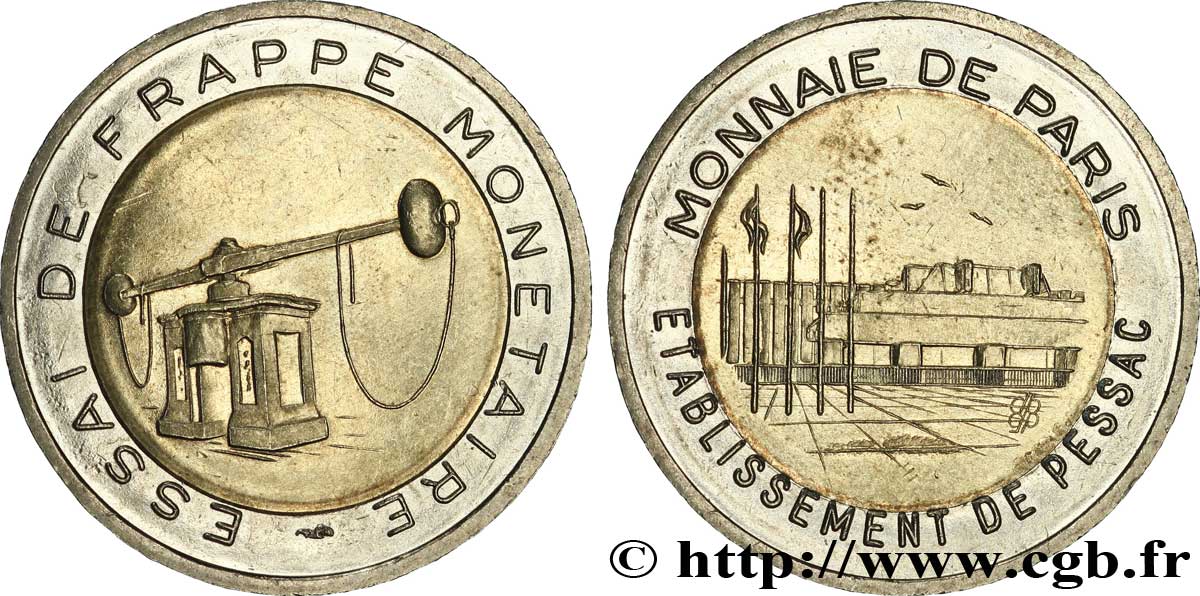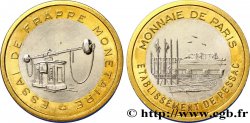- Accueil
- > Archiv
- > Euro Münzen
v50_0232 - EUROPÄISCHE ZENTRALBANK 2 euro, essai de frappe monétaire dit de “Pessac”, 3ème type n.d. Pessac
MONNAIES 50 (2011)
Startpreis : 1 500.00 €
Schätzung : 2 500.00 €
Erzielter Preis : 1 500.00 €
Anzahl der Gebote : 1
Höchstgebot : 2 222.00 €
Startpreis : 1 500.00 €
Schätzung : 2 500.00 €
Erzielter Preis : 1 500.00 €
Anzahl der Gebote : 1
Höchstgebot : 2 222.00 €
Type : 2 euro, essai de frappe monétaire dit de “Pessac”, 3ème type
Datum: n.d.
Name der Münzstätte / Stadt : Pessac
Prägemenge : ---
Metall : Kupfer-Nickel
Durchmesser : 25,73 mm
Stempelstellung : 12 h.
Gewicht : 8,43 g.
Rand cannelures fines et inscription LIBERTE EGALITE FRATERNITE
Seltenheitsgrad : R3
Kommentare zum Erhaltungszustand:
De légers coups de sac dans les champs et quelques marques de manipulation mais un exemplaire d’aspect SPL avec la totalité du brillant d’origine
N° im Nachschlagewerk :
Vorderseite
Titulatur der Vorderseite ESSAI DE FRAPPE MONETAIRE.
Beschreibung Vorderseite Balancier .
Rückseite
Titulatur der Rückseite MONNAIE DE PARIS - ETABLISSEMENT DE PESSAC.
Beschreibung Rückseite Représentation de l’usine de Pessac.
Kommentare
Les informations dont nous disposons actuellement font apparaître l’existence de trois types différents d’essais de frappe d’euros par l’établissement monétaire de Pessac. Le 3ème type fabriqué à partir de novembre 1998 est quasiment identique à la version définitive adoptée. La pièce est en frappe médaille, la couronne est non magnétique, l’insert (18 mm) est magnétique. Le poids et la taille sont ceux d’une pièce de 2 euro. Seule la tranche diffère puisque le type adopté pour les 2 euro françaises est “cannelures fines et 2 ** répété six fois, alternativement à l'endroit et à l'envers”.
The information we currently have indicates the existence of three different types of euro coinage tests by the Pessac Mint. The third type, produced from November 1998 onwards, is almost identical to the final version adopted. The coin is medal-struck, the crown is non-magnetic, and the insert (18 mm) is magnetic. The weight and size are those of a 2 euro coin. Only the edge differs, since the type adopted for the French 2 euro is “fine fluting and 2 ** repeated six times, alternately on the front and back.”
The information we currently have indicates the existence of three different types of euro coinage tests by the Pessac Mint. The third type, produced from November 1998 onwards, is almost identical to the final version adopted. The coin is medal-struck, the crown is non-magnetic, and the insert (18 mm) is magnetic. The weight and size are those of a 2 euro coin. Only the edge differs, since the type adopted for the French 2 euro is “fine fluting and 2 ** repeated six times, alternately on the front and back.”








 Berichten über einen Fehler
Berichten über einen Fehler Die Seite drucken
Die Seite drucken Teilen meiner Auswahl
Teilen meiner Auswahl Stellen Sie eine Frage
Stellen Sie eine Frage Einlieferung/Verkauf
Einlieferung/Verkauf
 Details
Details









